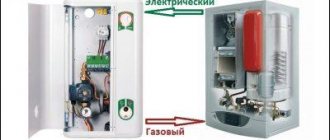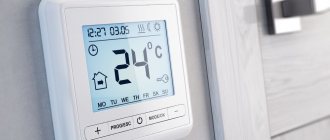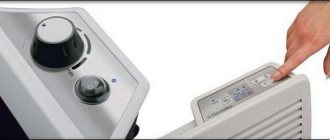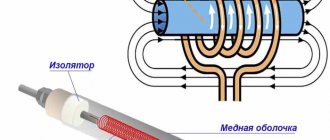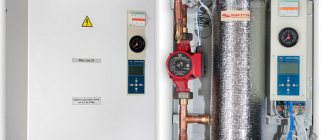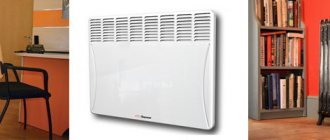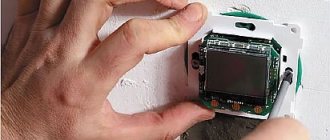For every family, a modern convector is a personal source of heat that can be used in chilly autumn or during a protracted spring. When the management company has not yet turned on the heating, and the apartment is already cool and damp, a comfortable solution would be to turn on the heater.
Buyers often ask about a universal heating device such as a convector: what is it? The device has a presentable body and a heating element; a special space in the lower part of the convector serves to draw in cold air into the room. The air is heated by a heating element and flows out through the upper part of the housing. It is designed in the form of blinds. Warm air rises towards the ceiling, after a while it cools and falls down, where it again enters the convector heating element. Gradual air circulation is the main principle of operation of a convector from any manufacturer.
Operating principle and design of the convector
To understand what a convector is, you need to understand how it works and on what principle it works. The functional performance of the device is associated with the convection process; it allows air to rise to the ceiling after it warms up and loses its density. The heater has a simple design and consists of:
- from the body;
- from a heating element.
A heating element is a conductor installed in a metal casing. Outwardly, it looks like a simple radiator heater and is located at the bottom of the device. When cold air gets in, it heats up. Then it rises and exits through the outlets, which are made at a slight slope. Rising to the ceiling, warm air gradually cools and falls down. Such heating with electric convectors allows you to heat the room evenly.
How it works?
An electric convector creates air circulation in the room, warming it up.
Regardless of the model or type, the operating principle of an electric convector is as follows: a flow of cold air is heated by passing through a hot surface (usually a heating element). The warm air flow rises, and when it cools, the air falls and goes through a new cycle .
Where to install
The convector is silent in operation, maintains precise temperature, does not burn or dry out the air, so it is excellent for home use. Since the device is afraid of drafts and rooms with poor insulation, the optimal solution is a bedroom, children's or guest room. Here the heater will provide a smooth temperature increase and maintain it for a long time in an economical mode. We do not recommend installing this equipment in warehouses, summer houses, garages, where there are drafts, uninsulated walls and windows that make the operation of the convector pointless .
Please note that for uniform temperature distribution and comfortable thermoregulation, it is important to choose the right installation location. Most often, convectors are mounted under a window, which allows them to neutralize the flow of cold air. For rooms with high ceilings, additional ceiling fans are used.
Types of convectors
There are many types of convectors, which are divided into several groups: by type of installation, by heating principle and by air circulation. Therefore, the choice of a convector is made according to its technical characteristics. Device types:
- The heater can be either with natural or forced air circulation.
- They come with electric, water or gas heating. Electric convectors for heating are also divided into infrared models.
- By mounting method - floor, wall.
Wall mounted
The wall-mounted heating device has compact dimensions. It comes in horizontal, vertical and ceiling types. The devices are available with or without a built-in thermostat. In appearance, heaters can be panel, film or have the appearance of tubular lamps. Based on the heating method, they are divided into infrared (thermal radiation) and convection (air circulation) models. Design features:
- Wall-mounted models are equipped with a flat box-shaped housing. The thickness of the case is small, but corresponds to the height of the device and, according to the principle of operation, is similar to a vertical pipe, the inlet and outlet of which have a temperature difference. Because of this, increased air draft is created. Thanks to this body shape and enclosed space, air enters the heater, thereby ensuring rapid heating.
- On the end side of the housing in the lower part there are small slots for the entry of cooled air.
- At the bottom of the device there is one or more heating elements, which are produced in the form of cast modules or a separate spiral. Elements are turned on simultaneously or one by one. The startup method depends on the selected mode.
- In the upper part of the case there are openings in the form of curtains. Hot air escapes through them. Curtain models are either movable or fixed. Using moving elements, you can adjust the air flow in any direction.
Choosing an installation location
Or rather, the question is not this: which convector is suitable for fulfilling your wishes. If you want to bring the appearance of the room closer to the standard one, you can hang rectangular wall convectors under the windows. Models that can be installed under the ceiling attract a little more attention, but they are inaccessible to children and pets - they will not be able to get burned or “adjust” in their own way. The installation method is the same here - on brackets fixed to the wall. Only the shape of the brackets differs.
You can choose any location for installing the electric convector. It is only advisable that it is not covered by furniture
If you want your heating appliances not to be visible, you will have to choose between baseboard and in-floor models. There is a big difference in installation: skirting boards are simply installed and connected to the network, but for in-floor ones you will have to make special recesses in the floor - their top panel should be on the same level as the finished floor. In general, you cannot install them without major repairs.
These are floor-mounted convectors. They are also electric
Calculate the required power
Power is the main indicator that needs to be taken into account when choosing a device. The level of heat produced by the convector depends on it. Calculation of required power:
- To heat a room measuring 10 to 12 square meters. m with a wall height of 2.7 m, 1 kW is required, provided that there are no other heating systems in the building.
- If a convector is installed in the building and there is another heating system, then the device will be able to heat a room area up to 24 square meters. m.
Large devices have the highest power. The larger the device, the stronger the power.
Installation of equipment
Installation of a floor heating convector must be carried out strictly according to the recommendations described in the attached operating instructions, especially when installing an option built into the floor. We begin the installation work with careful markings, the algorithm of all actions is clearly shown in this video
https://youtube.com/watch?v=PbXkRkZAax0
Pipe laying
When installing the system in a house under construction, all work is completed before finishing work and pouring the floors. The convector is connected to the water supply using metal braided hoses or non-ferrous metal pipes, but it is better to make a separate connection from the central heating.
When replacing a central heating radiator with a floor convector, we make the connection according to a previously installed and current scheme.
Level check
It is very important to install the product strictly horizontally - for this there are adjusting bolts on it. This rule applies to all convectors - located on the floor or built into it
After installation and performance testing, the final filling and leveling of the floor begins: the edge of the product body should not protrude above the floor level. The last thing, after the floor has completely dried, is the decorative grille.
Methods for adjusting temperature
Most electric convectors for heating are equipped with a mechanical control unit or an electronic one. With their help, it will be possible to control the heating level of the room, which allows you to save energy. The devices are also equipped with a control sensor and a power-on timer.
The first automatically turns the system on and off when the temperature reaches the desired value. After cooling, the device turns on independently or manually. This depends on the installed model.
The device can be programmed using the on timer. This is convenient when the temperature level in the rooms needs to be reduced during the daytime and increased at night.
An electronic thermostat and control unit allow you to set automatic temperature conditions, while in mechanical models it is set manually. There are models with remote control. The operation of the convector is controlled remotely using the control panel. Mobile devices have tip-over protection. If the convector accidentally turns over, the protection will work and it will turn off. The set temperature and the set mode are shown on the display.
Additional functions
For more convenient and comfortable operation of the devices, they are equipped with various additional functions.
- The automatic shut-off sensor is one of the main safety features that guarantees shutdown if the device overheats or when the set air temperature is reached.
- With the help of a built-in fan, the device heats the room faster. It also performs the function of cooling the heating element.
- The heater housing may have different degrees of protection. The IP index defines this degree. For example, to use the device in a bathroom or other wet rooms, a minimum IP24 index is required.
- An important feature is tip-over protection, which turns off the power if the device is in a horizontal position for some reason. Useful if there are children or pets in the house.
- The “Restart” function will simplify the adjustment of the device, as it remembers the previous settings (on time, temperature, etc.). If you turn off the device without this function, all settings will be reset.
- For cottages, garages or other premises where the owners appear extremely rarely, a convector with the “Anti-freeze” function is recommended. It starts working when the temperature drops to +5 degrees.
- Modern convectors contain an air ionizer, which can prevent certain diseases. The function works even if heating is not playing.
Safety precautions
Electric convectors require careful handling, like any electrical appliances. When using them, you need to remember the techniques for safe use of such units. For example, drying clothes directly on the body is considered a big mistake
The best outcome is for the device to overheat and turn it off if the protection is triggered. The worst case scenario is a fire.
For example, drying clothes directly on the body is considered a big mistake. The best outcome is for the device to overheat and turn it off if the protection is triggered. The worst case scenario is a fire.
The electrical outlet into which the convector is plugged in should be located on the side of the device, at a distance of 10 cm or more. Placing the socket on top is strictly prohibited.
If you take all these points into account, operation will be safe, the device will last a long time, and thanks to it the room will be warm and cozy.
